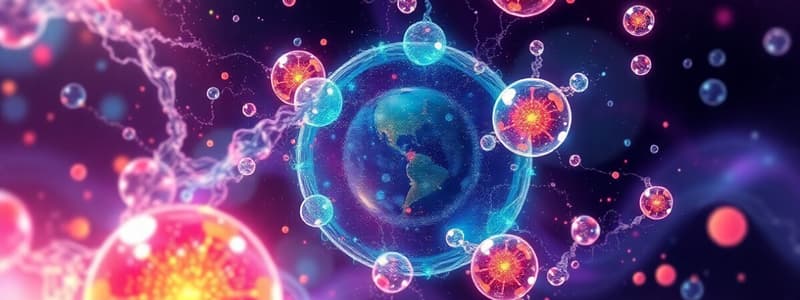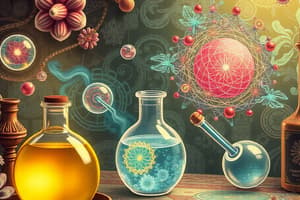Podcast
Questions and Answers
Which particle is responsible for determining the reactivity of an atom?
Which particle is responsible for determining the reactivity of an atom?
- Proton
- Molecule
- Electron (correct)
- Neutron
What is the primary compound found abundantly in the human body?
What is the primary compound found abundantly in the human body?
- Protein
- Water (correct)
- Sodium Chloride
- Glucose
What type of reaction involves breaking down molecules and releasing energy?
What type of reaction involves breaking down molecules and releasing energy?
- Catabolism (correct)
- Synthesis
- Hydrolysis
- Dehydration Synthesis
Which bond is formed by the sharing of electrons between atoms?
Which bond is formed by the sharing of electrons between atoms?
Which substance is an example of a buffer ion in the human body?
Which substance is an example of a buffer ion in the human body?
Which of the following is a monomer of carbohydrates?
Which of the following is a monomer of carbohydrates?
In living cells, what is the typical pH range maintained?
In living cells, what is the typical pH range maintained?
What process requires the addition of water to break a bond?
What process requires the addition of water to break a bond?
Which of the following is considered an acidic substance in the body? Select all that apply
Which of the following is considered an acidic substance in the body? Select all that apply
What happens to proteins when their hydrogen bonds are broken?
What happens to proteins when their hydrogen bonds are broken?
Which of the following best describes an ionic bond?
Which of the following best describes an ionic bond?
What is the main function of buffers in biological systems?
What is the main function of buffers in biological systems?
What is the pH level of gastric juice in the stomach primarily due to?
What is the pH level of gastric juice in the stomach primarily due to?
Which type of reaction is indicated by the equation 2H2O -> 2H2 + O2?
Which type of reaction is indicated by the equation 2H2O -> 2H2 + O2?
What are the primary components of organic compounds?
What are the primary components of organic compounds?
What type of reaction is known as dehydration synthesis?
What type of reaction is known as dehydration synthesis?
Which part of a nucleotide is not included in its composition?
Which part of a nucleotide is not included in its composition?
Which statement is true about catabolism?
Which statement is true about catabolism?
What is the monomer for proteins?
What is the monomer for proteins?
Which of the following substances has a high pH and is considered a base?
Which of the following substances has a high pH and is considered a base?
Flashcards are hidden until you start studying
Study Notes
Subatomic Particles
- Electron: negatively charged, found orbiting the nucleus of an atom.
- Proton: positively charged, located in the nucleus of an atom.
- Neutron: neutral charge, located in the nucleus of an atom.
Reactivity
- The reactivity of an atom is determined by its electrons.
Most Abundant Compound in the Body
- Water (H2O) is the most abundant compound in the human body.
Reactions
- Decomposition reactions break down molecules into smaller components.
- For example, the breakdown of water into hydrogen and oxygen: 2H2O -> 2H2 + O2.
- Catabolism is a type of decomposition reaction that releases energy.
- Examples include ATP to ADP + P, proteins to amino acids, and glycogen to glucose.
- Synthesis reactions build larger molecules from smaller components.
- Examples include amino acids building proteins and glucose building glycogen.
- Synthesis reactions require energy.
- Dehydration Synthesis is a specific type of synthesis reaction that involves the removal of water.
- Another name for this reaction is anabolic synthesis.
- Examples include amino acids building proteins and glucose building glycogen.
- Hydrolysis is a specific type of decomposition reaction that involves the addition of water.
- Another name for this reaction is catabolic decomposition.
- Examples include proteins to amino acids and glycogen to glucose.
Bonds
- Ionic Bonds form between charged particles (ions) that have lost or gained electrons.
- Covalent Bonds form when atoms share electrons.
- Hydrogen Bonds are intermolecular attractions between the negative atom of one molecule and a hydrogen atom of another molecule.
Electrolytes
- Electrolytes are substances that conduct an electric current because they contain ions.
Bases
- Bases have a high pH, contain OH- ions, and taste bitter.
Acids
- Acids have a low pH, contain H+ ions, taste sour, and are proton donors.
Bases in the Body
- Examples of bases in the body include semen, blood (slightly), and vaginal fluid.
Acids in the Body
- Examples of acids in the body include:
- Gastric juice (hydrochloric acid in the stomach)
- Lactic acid
- Sweat
pH of Living Cells
- The pH of living cells is typically between 7.35 and 7.45.
Buffers
- Buffers are substances that minimize changes in pH by donating or accepting H+ ions.
- Bicarbonate (HCO3-) is an example of a buffer ion.
Organic Compounds
- Organic compounds always contain hydrogen and carbon.
Monomers
- The monomers of various types of organic molecules are:
- Lipids: fatty acids and glycerol.
- Carbohydrates: monosaccharides.
- Nucleic acids: nucleotides.
- Proteins: amino acids.
Carbohydrates
- Glycogen, the stored form of carbohydrates, is found in the liver and muscles.
Nucleotides
- Nucleotides are composed of a sugar, a phosphate group, and a nitrogen base.
Proteins
- Proteins serve as structural components of tissues and act as enzymes.
- Denaturation occurs when the H+ bonds between proteins are broken, altering the shape and function of the protein.
Subatomic Particles
- Electrons carry a negative charge and orbit the nucleus.
- Protons carry a positive charge and are located in the nucleus.
- Neutrons carry no charge and are located in the nucleus.
Reactivity
- Electrons determine how an atom will interact with other atoms.
Important Body Compounds
- Water is the most abundant compound in the body.
Chemical Reactions
- Decomposition breaks down larger molecules into smaller ones.
- Catabolism, a type of decomposition, releases energy.
- Synthesis builds larger molecules from smaller ones.
- Anabolic synthesis (dehydration synthesis) requires energy and removes water.
- Hydrolysis breaks bonds by adding water.
- Catabolic decomposition is the breakdown of molecules using hydrolysis.
Chemical Bonds
- Ionic Bonds form between charged particles (ions) that have lost or gained electrons.
- Covalent Bonds form when atoms share electrons.
- Hydrogen Bonds are weak, intermolecular attractions between a negative atom in one molecule and a hydrogen in another.
Electrolytes
- Conduct an electrical current because they contain ions.
Acids and Bases
- Bases have a high pH, contain OH- ions, and taste bitter.
- Acids have a low pH, contain H+ ions, and taste sour.
- Acids donate protons (H+).
Body pH
- Semen, blood (slightly), and vaginal fluid are examples of basic solutions in the body.
- Gastric juice, lactic acid, and sweat are examples of acidic solutions in the body.
- Living cells maintain a pH of 7.35 to 7.45.
Buffers
- Buffers stabilize pH by donating or accepting H+ ions.
- Bicarbonate (HCO3-) is a common buffer.
Organic Compounds
- Organic compounds contain both hydrogen and carbon.
Monomers
- The monomer of a lipid is fatty acids and glycerol.
- The monomer of a carbohydrate is a monosaccharide.
- The monomer of a nucleic acid is a nucleotide.
- The monomer of a protein is an amino acid.
Carbohydrates
- Glycogen is the stored form of carbohydrates in the liver and muscles.
Nucleotides
- Consist of sugar, phosphate, and a nitrogen base.
Proteins
- Provide structure for tissues and act as enzymes.
- Denaturation occurs when bonds between proteins are broken.
Studying That Suits You
Use AI to generate personalized quizzes and flashcards to suit your learning preferences.




